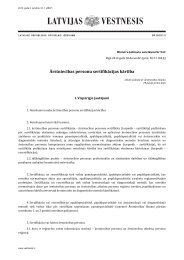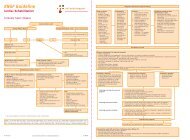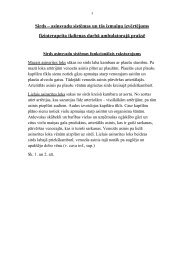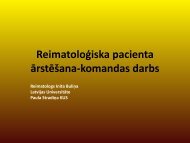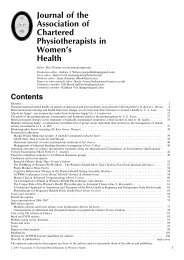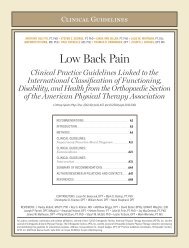KNGF Guideline Cardiac rehabilitation
KNGF Guideline Cardiac rehabilitation
KNGF Guideline Cardiac rehabilitation
Create successful ePaper yourself
Turn your PDF publications into a flip-book with our unique Google optimized e-Paper software.
<strong>KNGF</strong> Clinical Practice <strong>Guideline</strong> for physical therapy in patients undergoing cardiac <strong>rehabilitation</strong><br />
Practice <strong>Guideline</strong>s<br />
The resulting indication is then discussed at a multidisciplinary<br />
meeting, after which the patient is referred to one or more of the<br />
following programs offered by the various disciplines:<br />
• information program:<br />
- the patient (and their partner, if any) is offered information<br />
about their disease and ways of coping with it, as<br />
well as about the way cardiac <strong>rehabilitation</strong> can facilitate<br />
physical, psychological and social recovery;<br />
- the patient is offered information about legal and other<br />
regulations relevant to regaining social participation;<br />
• exercise program (in the relevant multidisciplinary setting);<br />
• relaxation program;<br />
• assisting behavior change (lifestyle program, behavior modification<br />
program);<br />
• psychological programs;<br />
- psycho-education (educating patients about cardiac problems<br />
and how to deal with them);<br />
- program to treat psychological symptoms (various programs):<br />
e.g. stress management, cognitive behavioral<br />
therapy.<br />
The patient then goes through specific intake procedures for each<br />
of the relevant disciplines, after which they start one or more<br />
cardiac <strong>rehabilitation</strong> programs. If outpatient cardiac <strong>rehabilitation</strong><br />
is contra-indicated, the patient may be referred to a clinical setting<br />
for cardiac <strong>rehabilitation</strong>, such as a specialized <strong>rehabilitation</strong><br />
center.<br />
A.3.1 Diagnostic process for coronary heart disease in Phase II<br />
The aim of the diagnostic process in physical therapy is to assess<br />
the nature and severity of the patient’s health problem in relation<br />
to their physical functioning and to assess the extent to which<br />
it can be modified. The assessment is based on the patient’s<br />
presenting problem and the physical improvement that can be<br />
expected.<br />
The physical therapist assesses the patient’s health status, starting<br />
from the main symptoms, identifies the target situation, checks for<br />
the presence of favorable and unfavorable factors and assesses the<br />
patient’s need for information. Based on the findings, the physical<br />
therapist determines the <strong>rehabilitation</strong> goals.<br />
The diagnostic process involves history-taking, physical examination,<br />
analysis and designing a treatment plan.<br />
History-taking<br />
The details of the patient’s history are partly obtained from the<br />
<strong>rehabilitation</strong> team (including the referral information provided by<br />
the cardiologist) and partly from the patient.<br />
Focal points in history-taking include:<br />
• identifying the patient’s presenting problem or the target<br />
activity level (preferably using the patient-specific complaints<br />
[PSC] instrument);<br />
• identifying the patient’s activity level before the current health<br />
status arose;<br />
• exploring the patient’s health status:<br />
- nature and severity of complaints (in terms of body functions,<br />
activities and participation);<br />
- start, duration and course of the coronary heart disease;<br />
- prognosis and risk factors (risk factor checklist);<br />
- comorbidities;<br />
- physical activity behavior;<br />
• assessing the patient’s current status:<br />
- functional impairments, activity limitations (preferably<br />
assessed using the PSC instrument) and restrictions of participation<br />
associated with the coronary heart disease;<br />
- current general health status (in terms of body functions,<br />
activities and participation);<br />
- internal and external factors that may affect the recovery<br />
process;<br />
- current treatment: medication / additional treatment;<br />
• other information:<br />
- personal details:<br />
- social details (occupational, family);<br />
- demands made on the patient by their environment;<br />
- motivation;<br />
- the patient’s information requirements.<br />
Physical examination<br />
The examination focuses on identifying impairments of body<br />
functions, limitations of activities, restrictions of participation and<br />
health problems that may influence the choice of exercise activities<br />
to be included in the <strong>rehabilitation</strong> program. Limitations of activities<br />
may regard their nature, duration and / or quality.<br />
The physical therapist analyses the performance of problematic<br />
activities that were identified using the PSC instrument. The physical<br />
therapist assesses the quality of the patient’s basic motor skills<br />
(including endurance, strength, speed, agility and coordination)<br />
and the degree to which the patient is able to use them.<br />
The performance of the problematic activities can be scored in<br />
terms of duration and intensity, perceived fatigue (Borg Rating<br />
of Perceived Exertion (RPE) scale 6-20) and possibly in terms<br />
of anxiety, chest pain and dyspnea (on the Anxiety, Angina and<br />
/ or Dyspnea scales). If requested by the patient’s physician, the<br />
therapist can monitor the patient’s heart rate and blood pressure<br />
during these activities. The Shuttle walk test (SWT) or the 6-minute<br />
walk test (6MWT) is used to determine the patient’s functional<br />
exercise capacity. The MET method and/or the Specific Activity Scale<br />
(SAS) can be used to estimate whether any discrepancy between<br />
the actual performance level and the target level can be eliminated<br />
with a suitable exercise program.<br />
Part of the examination involves the physical therapist observing<br />
how the patient copes with their health problem, for instance if<br />
they show fear of exercise. As regards the patient’s psychosocial<br />
functioning, the role of the physical therapist is to signal and<br />
report any problems.<br />
Analysis<br />
The analysis of the patient’s health problems focuses on the following<br />
questions:<br />
1 What is the patient’s current health status in terms of body<br />
functions and structures (impairments), activities (limitations)<br />
and participation (restrictions) and what is the patient’s current<br />
physical condition in terms of:<br />
- basic motor skills (endurance, strength, speed, agility<br />
and coordination while performing activities, assessed by<br />
means of the PSC instrument);<br />
- functional exercise capacity (SWT or 6MWT, possibly supplemented<br />
by the MET method or the SAS).<br />
V-08/2011<br />
5



